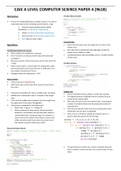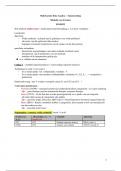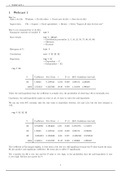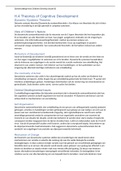UNIVERSITY OF PERADENIYA
PH205 - Statistical and Thermal Physics
Note 10
Quantum Statistics I
So far we have discussed the classical statistics which is the Maxwell-Boltzmann statistics. In
classical statistics we considered distinguishable particles, hence interchange of any two particles
in a given partition will lead to a new arrangement within the system.
However considered particles in quantum statistics should be identical and indistinguishable.
Hence interchange of two particles will not give a new arrangement. There are two kinds of
quantum statistics namely Fermi-Dirac statistics and Bose-Einstein statistics. However at very
high temperatures and low densities quantum statistics reduce to classical statistics.
(i.) Fermi-Dirac Statistics
Particles considered in this statistics are obeying Pauli exclusion principle that means two
identical particles can not be in the same energy state. Particles obeying these conditions
are known as fermions which are the particles with half-integer spin.
(ii.) Bose-Einstein Statistics
Particles considered in this statistics are not obeying Pauli exclusion principle that means
more than one identical particles can be in the same energy level. These type of particles
are known as bosons which are the particles with integer spin.
• Fermi-Dirac Statistics
Particles in Fermi-Dirac statistics are identical, indistinguishable fermions that obey Pauli
exclusion principle. To compute the probability of a partition of a system of fermions, first we
have to redefine the intrinsic probability, gi . In quantum statistics gi is the number of states
corresponds to a given energy that is the degeneracy of the energy level. One can see that the
value gi gives the maximum number of fermions which can be accommodated in an energy level
without violating the exclusion principle.
Consider some energy level Ei with degeneracy gi . We are going to fill this energy level with
ni number of fermions. Since there are gi number of degenerate states,
⇒ we can place the first fermion in any of the gi states available that means we have gi
number of different ways of placing the first fermion in the energy level.
⇒ the second fermion can be placed in remaining (gi -1) states that means there are (gi -1)
number of different ways of placing the second fermion.
⇒ similarly the third fermion can be placed in (gi -2) number of different ways.
1
, Hence the total number of different ways of arranging the ni number of fermions among the
gi number of available states with energy Ei is given by
gi !
gi (gi − 1)(gi − 2).....................(gi − (ni − 1)) =
(gi − ni )!
So far we have taken into account only the exclusion principle. Since the fermions are indis-
tinguishable, it is not possible to recognize any difference if the fermions are reshuffled among
the states they are occupying in levels of energy Ei . Therefore the total number of different and
distinguishable arrangements of ni fermions among gi available states of energy Ei can be given
by
gi !
ni !(gi − ni )!
Consider some partition of a fermion system such that n1 , n2 , n3 , . . . . . . number of fermions
are among the energy levels E1 , E2 , E3 , . . . . . . having degeneracies g1 , g2 , g3 , . . . . . . respectively.
Total number of different and distinguishable ways of obtaining the partition can be then given
by
g1 ! g2 ! g3 ! Q gi !
P = × × ×...... = ........... (a)
n1 !(g1 − n1 )! n2 !(g2 − n2 )! n3 !(g3 − n3 )! i ni !(gi − ni )!
This is called probability of partition.
Fermi-Dirac Distribution Law (The most probable partition)
To find the most probable partition of a given system of fermions, we should maximize the
probability of the partition subjected to the conditions
P
ni = N = constant ............................. (i)
i
P
ni Ei = U = constant ............................. (ii)
i
Using Stirling approximation equation (a) can be simplified as
P
lnP = {gi lngi − ni lnni − (gi − ni )ln(gi − ni )}
i
Then the variation of lnP becomes
P
−dlnP = {lnni − ln(gi − ni )} dni
i
P P
By conditions (i) and (ii); dN = dni = 0 and dU = Ei dni = 0
i i
Selecting two parameters α and β such that −dlnP + α dN + β dU = 0
P
⇒ {lnni − ln(gi − ni ) + α + β Ei } dni = 0
i
This should valid for any ni hence lnni − ln(gi − ni ) + α + β Ei = 0
gi
⇒ ni = ......................... (b)
1 + e(α+βEi )
This represents the Fermi-Dirac distribution law.
The parameter β plays the same role as in Maxwell-Boltzmann statistics. Temperature of
the system of fermions in statistical equilibrium is defined by β = 1/kT .
2










